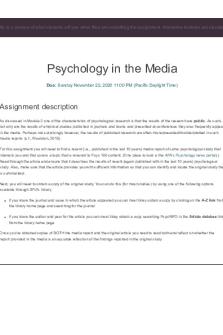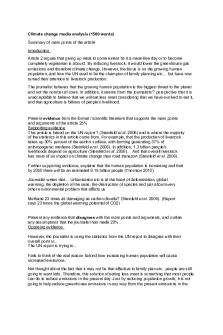PCN107.T2 Media Analysis Worksheet PDF

| Title | PCN107.T2 Media Analysis Worksheet |
|---|---|
| Course | Introduction to Counseling Theories |
| Institution | Grand Canyon University |
| Pages | 3 |
| File Size | 169.5 KB |
| File Type | |
| Total Downloads | 48 |
| Total Views | 123 |
Summary
Watch a film or television show, listen to a radio program, or read a short story with an identified main character. Answer the following questions with a minimum of 250 words each.
Topic 2
Week 2
Assignment was a waste of time so I hope this helps you....
Description
Topic 2: Influence of Race and Ethnicity: Media Analysis Worksheet Kelly Gootee PCN 107 Kristie Winkler
Directions: Watch a film or television show, listen to a radio program, or read a short story with an identified main character. Answer the following questions with a minimum of 250 words each. 1. What is the name of the show/movie/story and who was the main character examined? The show I chose to watch was an episode of “The Big Bang Theory,” which has an ensemble cast; however, in this episode it focused on Sheldon Cooper and his relationship problems with his girlfriend Amy. Sheldon, a physicist and genius is a bit socially awkward and this is exemplified in his relationship with Amy that has been ongoing for five years. Amy has always been patient with Sheldon as he is a bit quirky. He is a very structured person with a rigid schedule and many ritualistic compulsive behaviors. Often, Sheldon can come across as rude, uncaring, and selfish but in reality he just lacks the ability to “filter” what he says and he is brutally honest. Often, to the detriment of his significant other. Sheldon comes from a stable home where his mother and father were married until his father’s passing. For the benefit of this assignment, the relationship between the two characters is the focal point with Sheldon’s character flaws being discussed. In particular, Amy decides to break up with Sheldon after a prolonged period of intimacy issues. She feels that Sheldon has a lack of feelings for her and needs more romance and emotional support in the relationship. 2. Briefly describe the conflict the main character experienced, what drove the story? The conflict that is depicted within the relationship between Amy and Sheldon is his lack of intimacy and ‘connectedness’ within the bond. Amy does not feel that Sheldon feels “love” for her as he is easily distracted and lacks physical and emotional intimacy. She is also beginning to feel that he is not attracted to her. This is a regular problem in their relationship and she has made multiple attempts at trying to get Sheldon to open up and be more romantic. It is their fifth anniversary and the couple returns home after a date and they share an embrace which leads to a kiss. Amy opens up emotionally to Sheldon and begins to discuss their 5-year journey and is interrupted by Sheldon talking about his favorite TV series, ‘The Flash’. After becoming upset, she asks him how he could be thinking about a TV show while they were kissing and not about her. He responds by saying that he was going to ask her if she wanted to watch it with him. Amy © 2019. Grand Canyon University. All Rights Reserved.
is very hurt by this and consequentially this leads to her breaking up with Sheldon who has a hard time accepting this and follows her around incessantly and refuses to give her time to think things through. 3. Using Freud’s theory, what psychodynamic structures (id, ego, and superego) were in conflict, what were the desires of each structure? e.g., A boy’s Id may want the boy to ask a girl out but his Ego might resist the urge because he could get turned down and feel hurt. Based upon Freud’s theory our behaviors are a result of our Id, Ego, and Superego; which are unseen categories of the brain which try to regulate emotions, memories, and behaviors. The Id is instinctually based and primal in nature and functions mostly without our conscious knowledge. The ego is the referee between the Id and Superego trying to maintain emotional homeostasis. The Superego strives for perfection and measures acceptability mostly on what was considered right/wrong by parental figures (Corey, 2017). In regard to Sheldon’s relationship and upbringing his mother is a devout Christian who does not believe in intimacy before marriage. So I believe there are multiple conflicts occurring here with Sheldon. During the moment during the kiss, Sheldon’s impulses to blurt out a statement regarding his favorite TV program shows that the impulsive, immature nature of his ID was in conflict with the reality of his Ego, unaffected by the potential damage to his relationship. His Superego was also conflicted here by because he was weighing the potential acceptability of his behavior, from his mother’s Christian worldview, to act on his intimate feelings of his Id. In addition, the Id is ruled by the pleasure principle, where the M.O. is to gain pleasure and release tension. Perhaps in this conflicted moment, the distraction of “The Flash” helped him to release tension. 4. Review psychoanalytic defense mechanisms, identify and describe three defenses used by any of the characters in the show. According to Table 4.1 in “Theory and Practice of counseling and Psychotherapy,” psychoanalytic defense mechanisms are employed by the ego in order to attempt to compromise with both the Id and Superego. These common defense mechanisms include: repression, denial, reaction formation, projection, displacement, rationalization, sublimation, regression, introjection, identification, and compensation (Corey, 2017). One defense mechanism which appeared to be used by Sheldon at this moment was sublimation. He was diverting sexual energy elsewhere. In this moment while kissing his girlfriend he chose to begin discussing a TV show, which was a major diversion. After the breakup, Sheldon exhibited both repression and denial while failing to acknowledge Amy’s feelings. He subconsciously chose not to acknowledge her pain and what she was feeling because that would lead him to have to face his own painful emotions. This is a perfect example of repressing one’s emotions. Denial is one of the most commonly known defense mechanisms. It occurs when someone choses to ignore a component of their life that is upsetting to them, unlike repression denial mostly occurs in the preconscious and conscious mind as opposed to subconsciously (Corey, 2017). In this instance, not acknowledging the breakup and denying that it was happening by showing up to places that he © 2019. Grand Canyon University. All Rights Reserved.
knew Amy was and acting like nothing occurred or as if they were still a couple, was a classic manifestation of denial. 5. Using Adler’s Individual psychotherapy, briefly describe how feelings of inferiority may contribute to the conflict in the media observed. Alfred Adler’s personality development theories involve inferiority and superiority complexes, which he argues are major factors for human motivation. Complexes are a result of learned behavior as a result of defense mechanisms which become habit, thus affecting one’s personality (Bagby, 1923). Sheldon’s behavior could be caused by an inferiority complex as a result of feelings of intimate inadequacy. Possibly due to his lack of experience with intimacy, he feels like he may not be good enough for her, so he uses distraction to avoid it. In this case, the distraction was discussing a TV program in the heat of the moment. Someone like Sheldon, a scientific prodigy, is used to knowing it all and being in control of their chosen environment. In this case, he is completely out of his element and in opposition to his usual superiority complex he is scared and not used to feeling this way. Unintentionally, he has made his girlfriend feel inferior and not attractive resulting in an undesired circumstance he chose to deny.
References Bagby ,E.( 1923) .Thei nf er i or i t yr eact i on.TheJour nal ofAbnor mal Ps y c hol ogyandSoci al Ps y chol ogy,18( 3) ,269–273.ht t ps : / / doi or g. l opes. i dm. ocl c. or g/ 10. 1037/ h0066946 Corey, G. (2017). Theory and Practice of Counseling Psychotherapy. (Tenth Edition). Cengage Learning. Boston, MA.
© 2019. Grand Canyon University. All Rights Reserved....
Similar Free PDFs

Media Analysis Worksheet
- 8 Pages

Media Analysis Worksheet
- 2 Pages

Media Analysis Assignment
- 3 Pages

Social Media Analysis
- 5 Pages

Social Media Analysis
- 6 Pages

N. Phipps - Media Analysis
- 3 Pages

Media Analysis final - English
- 4 Pages

Media analysis outline (grade)
- 2 Pages

Media Artifact Analysis: Android
- 2 Pages

Visual Analysis Worksheet 2
- 2 Pages
Popular Institutions
- Tinajero National High School - Annex
- Politeknik Caltex Riau
- Yokohama City University
- SGT University
- University of Al-Qadisiyah
- Divine Word College of Vigan
- Techniek College Rotterdam
- Universidade de Santiago
- Universiti Teknologi MARA Cawangan Johor Kampus Pasir Gudang
- Poltekkes Kemenkes Yogyakarta
- Baguio City National High School
- Colegio san marcos
- preparatoria uno
- Centro de Bachillerato Tecnológico Industrial y de Servicios No. 107
- Dalian Maritime University
- Quang Trung Secondary School
- Colegio Tecnológico en Informática
- Corporación Regional de Educación Superior
- Grupo CEDVA
- Dar Al Uloom University
- Centro de Estudios Preuniversitarios de la Universidad Nacional de Ingeniería
- 上智大学
- Aakash International School, Nuna Majara
- San Felipe Neri Catholic School
- Kang Chiao International School - New Taipei City
- Misamis Occidental National High School
- Institución Educativa Escuela Normal Juan Ladrilleros
- Kolehiyo ng Pantukan
- Batanes State College
- Instituto Continental
- Sekolah Menengah Kejuruan Kesehatan Kaltara (Tarakan)
- Colegio de La Inmaculada Concepcion - Cebu





